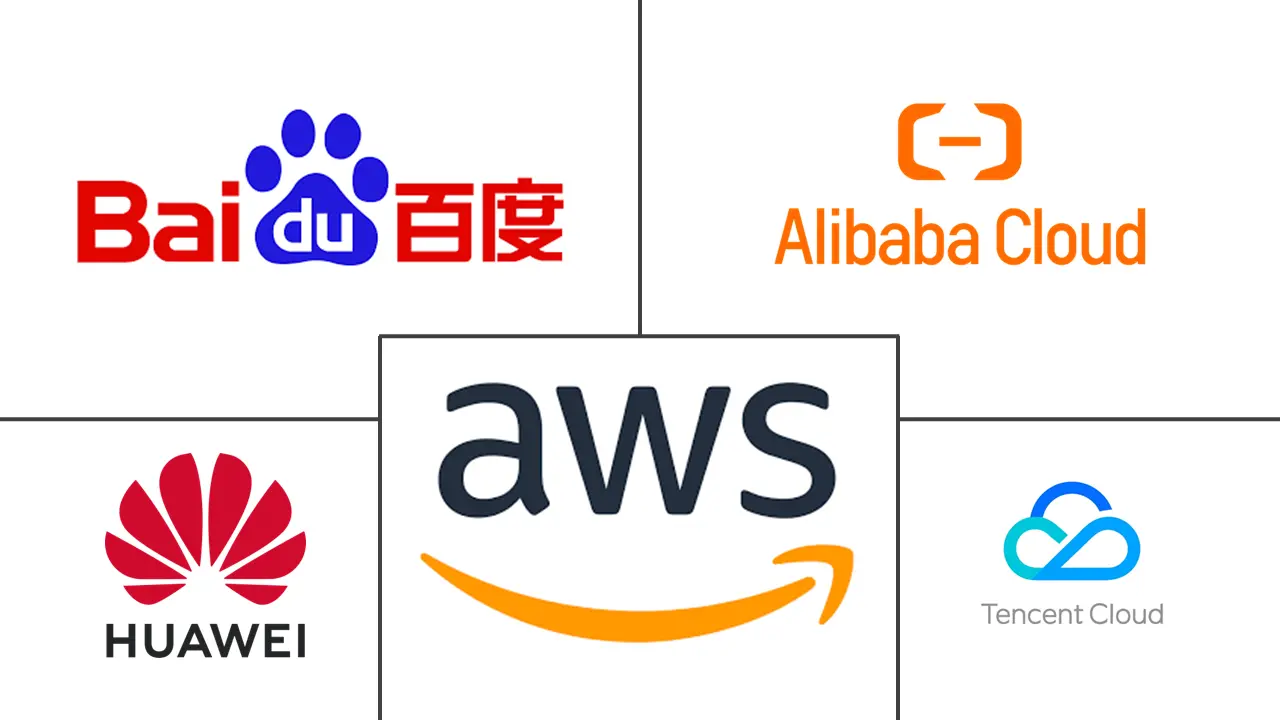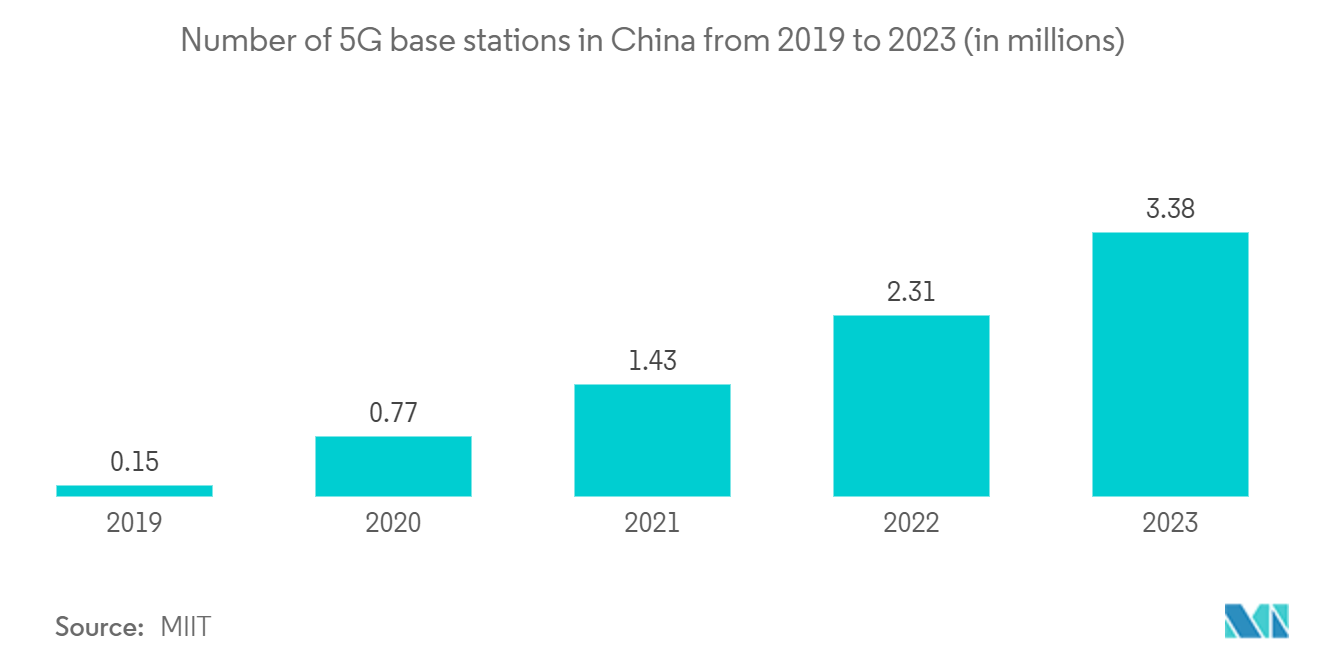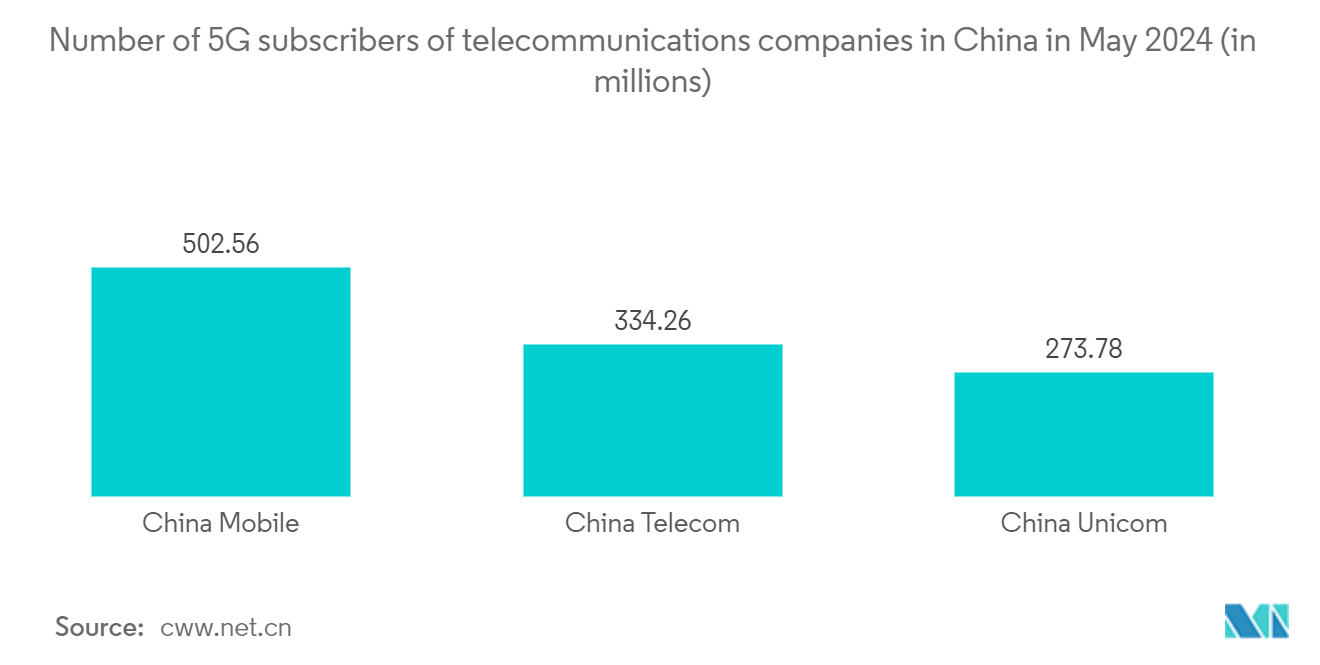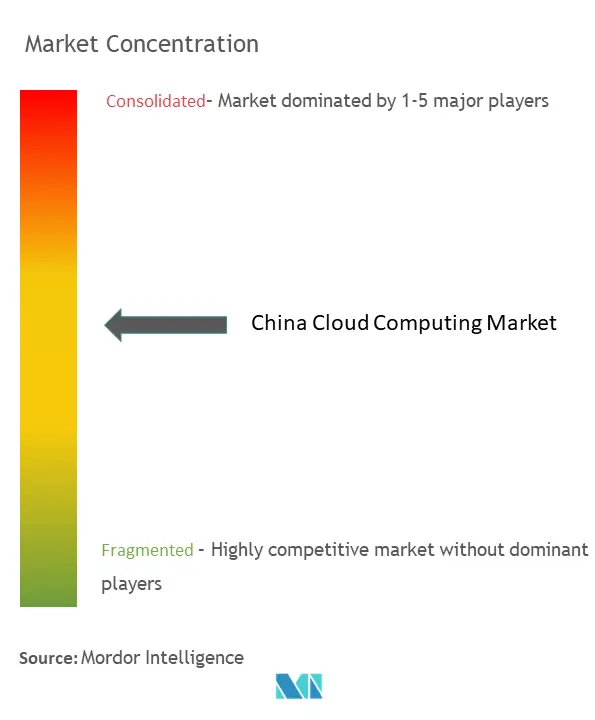China Cloud Computing Market Size

| Study Period | 2019 - 2029 |
| Base Year For Estimation | 2023 |
| Market Size (2024) | USD 48.01 Billion |
| Market Size (2029) | USD 111.93 Billion |
| CAGR (2024 - 2029) | 18.45 % |
| Market Concentration | Medium |
Major Players
*Disclaimer: Major Players sorted in no particular order |
China Cloud Computing Market Analysis
The China Cloud Computing Market size is estimated at USD 48.01 billion in 2024, and is expected to reach USD 111.93 billion by 2029, growing at a CAGR of 18.45% during the forecast period (2024-2029).
- China's cloud computing market is witnessing significant growth, propelled by government initiatives, technological progress, and a concerted effort toward modernization in various sectors. This momentum is heavily shaped by strategic government plans, including the "Made in China 2025" initiative and "Internet Plus." The widespread embrace of technologies such as artificial intelligence (AI), big data, cloud computing, and the Internet of Things (IoT) is transforming traditional business models, boosting operational efficiencies, and spurring innovation.
- Major tech giants like Alibaba and Huawei are pivotal players in this landscape. Alibaba's vast ecosystem spans e-commerce, cloud computing, and fintech, offering holistic digital solutions. For instance, in 2024, Chinese tech giants Alibaba and Baidu reduced the prices of their large-language models (LLMs). Other companies and developers in China use these models to train their generative artificial intelligence (AI) products. This move comes as a price war in the cloud computing sector heats up in China. These solutions empower businesses to streamline operations and broaden their audience reach. Alibaba Cloud, the company's cloud division, delivers scalable computing resources and sophisticated analytics. This enables businesses to leverage big data and AI, not just for enhanced operational efficiency but also for innovative strides in product development and customer engagement.
- Furthermore, Chinese businesses across various industries are increasingly adopting digital technologies to improve efficiency, reduce costs, and enhance customer experiences. Cloud computing offers the necessary flexibility and scalability to support these digital transformation initiatives.
- Additionally, China's focus on building smart cities has fueled the adoption of IoT devices and AI applications, which require robust cloud infrastructure for data processing, analysis, and management. Moreover, the integration of IoT technologies in manufacturing and other industries has created a demand for cloud-based solutions to optimize operations and improve productivity.
- However, while cloud computing offered on-demand platforms, software, and infrastructure, it remained susceptible to data breaches. Despite assurances of robust security measures, customers voiced concerns about entrusting their data to public cloud services. Even with diligent efforts from cloud service providers to safeguard client data, notable data breach incidents impacted some of the industry's most prominent players.
China Cloud Computing Market Trends
Major Advancements in Digital Change Nationwide
- Cloud computing fostered innovation by providing access to advanced technologies, such as artificial intelligence (AI), machine learning (ML), and big data analytics. Organizations experimented and innovated without significant upfront investments. For instance, in 2023, China operated 448 data centres, trailing behind the UK (517), Germany (522), and the global frontrunner, the USA (5,375).
- Additionally, 2023 witnessed a heightened global footprint for Chinese cloud providers, largely fueled by the fervour surrounding generative AI. Moreover, Ii October 2023, the government set an ambitious target, announcing plans to double its cloud computing market by 2025. Moreover, retailers leveraged AI for enhanced customer insights, supply chain optimization, and dynamic pricing strategies. E-commerce platforms use AI to provide personalized shopping experiences and improve customer retention.
- Furthermore, as organizations digitized their operations, ensuring data security and regulatory compliance became a priority. Many cloud providers offer robust security measures and compliance with regulations, making them attractive to organizations handling sensitive data. Alibaba Cloud, the cloud computing arm of the tech giant Alibaba Group Holding Ltd, unveiled intentions to debut its inaugural cloud region in Mexico.
- Additionally, cloud computing enhanced digital transformation by evolving it from merely adopting new technology to a comprehensive restructuring of processes, tools, and experiences in a remote, virtual environment. Cloud solutions improve security, enhance user experience, and protect data integrity. Consequently, businesses increasingly incorporated cloud technologies into their operations, driving the growth of the cloud computing market.
- In parallel to this, numerous banking and fintech entities steadily transitioned to cloud technology since its inception. The financial sector experienced rapid growth in data creation and utilization. This transition enhanced transparency and gave consumers greater control over auditing processes and data management. Additionally, it offered a more flexible method for data classification.
- In June 2024, Akamai Technologies, Inc. forged a strategic partnership with Digital China, a prominent player in digital transformation, aiming to amplify Akamai's enterprise security solutions within China. This collaboration designates Digital China as Akamai's inaugural enterprise security distribution partner in the nation. Capitalizing on this partnership, both entities are set to introduce Akamai's state-of-the-art enterprise security products and solutions, complemented by customized service experiences tailored for Chinese businesses.

Telecom is Expected to Grow at a Significant Rate
- China's rollout of 5G networks is fueling a rising demand for cloud-based solutions. These networks, demanding substantial computational resources, are essential for managing heightened data traffic and facilitating new applications. For instance, as of Q1 2023, GSMA Intelligence reported that 198 operators launched 5G services, including Fixed Wireless Access (FWA), across 77 markets. Globally, 5G connections constituted 8% of all mobile links. Operators are projected to invest 85% of the USD 620 billion global mobile CAPEX on 5G from 2023 to 2025. Dominating the scene, China accounted for 68% of all global 5G connections as of Q1 2023, with local operators aiming to set up 2 million 5G base stations by the close of 2023.
- Furthermore, the IT sector is witnessing significant growth, spearheaded by giants like Alibaba and Tencent. Alibaba, once solely an e-commerce leader, has branched out into cloud computing, digital payments, and artificial intelligence. Its cloud division, Alibaba Cloud, has emerged as a key global player, providing scalable and secure solutions that drive the digital transformation of businesses worldwide. Additionally, Alibaba's AI innovations, embedded across its platforms, have transformed industries like retail, finance, and logistics, equipping businesses with advanced tools for enhanced efficiency and customer interaction.
- Moreover, telecommunications firms are harnessing cloud-based tools to refine their network infrastructure, boost performance, and cut costs. By adopting cloud technologies, these operators can streamline network management, delve into data analytics, and swiftly pinpoint potential challenges. For instance, a report from the MIIT highlighted that mainland Chinese operators had set up over 1.4 million 5G base stations. Building on this, the MIIT has ambitiously targeted a tripling of this number to 3.64 million by the close of 2025.
- In addition, cloud computing is pivotal for telecoms aiming to elevate customer experiences. These platforms facilitate service personalization, real-time support, and behavioral analytics to discern trends and preferences. Notably, SASAC has endorsed 36 centrally owned enterprises to roll out cloud platforms spanning 40 industries. Additionally, China Telecom's cloud infrastructure underpins 24 of these 40 industry platforms.
- With intensifying competition in the telecommunications realm, companies are seeking avenues for differentiation and profitability. Cloud computing emerges as a strategic ally, empowering telecom operators to introduce innovative services, curtail expenses, and bolster operational efficiency.

China Cloud Computing Industry Overview
China's cloud computing market has experienced notable semi-consolidation, where a few large players compete for market share while smaller companies still maintain a significant presence. Moreover, many of these companies formed strategic partnerships and expanded into new markets to strengthen their positions. Furthermore, key players included the industry's key providers such as Alibaba Cloud, Tencent Cloud, Huawei Cloud, and Baidu AI Cloud, among others.
China Cloud Computing Market Leaders
-
Alibaba Cloud Internationa (Aliyun)
-
Tencent Cloud
-
Huawei Software Technologies Co., Ltd.
-
Baidu Cloud (Baidu, Inc.)
-
Amazon Web Services, Inc.
*Disclaimer: Major Players sorted in no particular order

China Cloud Computing Market News
- February 2024: Alibaba Cloud announced a historic price cut, reducing prices by up to 55% on over 100 core cloud products. The company stated that this initiative seeks to democratize public cloud services in the age of artificial intelligence and accelerate the widespread adoption of cloud computing across various sectors.
- February 2024: Tencent launched a new microgrid at its High-Tech Cloud Data Center located in Tianjin. Boasting a total installed capacity of 10.54 MW, the microgrid is projected to generate 12 million kWh of electricity annually enough to power 6,000 households, as per the company's statement.
China Cloud Computing Market Report - Table of Contents
1. INTRODUCTION
- 1.1 Study Assumptions and Market Definition
- 1.2 Scope of the Study
2. RESEARCH METHODOLOGY
3. EXECUTIVE SUMMARY
4. MARKET INSIGHTS
- 4.1 Market Overview
-
4.2 Industry Attractiveness - Porter's Five Forces Analysis
- 4.2.1 Bargaining Power of Suppliers
- 4.2.2 Bargaining Power of Consumers
- 4.2.3 Threat of New Entrants
- 4.2.4 Threat of Substitute Products
- 4.2.5 Intensity of Competitive Rivalry
5. MARKET DYNAMICS
-
5.1 Market Drivers
- 5.1.1 Robust Shift Towards Digital Transformation Across the Country
- 5.1.2 Data Privacy Concerns Are Driving Increased Adoption Of Public Cloud Services
-
5.2 Market Challenges
- 5.2.1 Regulatory Compliance and Data Breaching Risk
- 5.3 Pricing Model Analysis
-
5.4 Overview of demand trends of Cloud Computing in China
- 5.4.1 Increased adoption of hybrid and multi-cloud strategies
- 5.4.2 Rising adoption if SaaS Applications
- 5.5 Number of data centres in China
- 5.6 Industry Regulations and Standards for Cloud Computing Market in China
- 5.7 Case Study Analysis
6. MARKET SEGMENTATION
-
6.1 By Type
- 6.1.1 Public Cloud
- 6.1.1.1 IaaS
- 6.1.1.2 PaaS
- 6.1.1.3 SaaS
- 6.1.2 Private Cloud
- 6.1.3 Hybrid Cloud
-
6.2 Organization Size
- 6.2.1 SMEs
- 6.2.2 Large Enterprises
-
6.3 End-user Industries
- 6.3.1 Manufacturing
- 6.3.2 Education
- 6.3.3 Retail
- 6.3.4 Transportation and Logistics
- 6.3.5 Healthcare
- 6.3.6 BFSI
- 6.3.7 Telecom and IT
- 6.3.8 Government and Public Sector
- 6.3.9 Others (Utilities, Media & Entertainment etc)
7. COMPETITIVE LANDSCAPE
-
7.1 Company Profiles*
- 7.1.1 Alibaba Cloud Internationa (Aliyun)
- 7.1.2 Tencent Cloud
- 7.1.3 China Telecom Cloud
- 7.1.4 Amazon Web Services, Inc.
- 7.1.5 Huawei Software Technologies Co., Ltd.
- 7.1.6 Kingsoft Cloud Holdings Ltd
- 7.1.7 Baidu Cloud (Baidu, Inc.)
- 7.1.8 Inspur Cloud (Inspur Group Co., Ltd.)
- 7.1.9 China Unicom Cloud (China Unicom Global Limited)
- 7.1.10 China Mobile Cloud (China Mobile International Limited)
8. MARKET OPPORTUNITIES AND FUTURE TRENDS
** Subject To AvailablityChina Cloud Computing Industry Segmentation
Cloud computing delivers computing services via the internet, encompassing servers, storage, databases, networking, software, analytics, and intelligence. This approach fosters quicker innovation, adaptable resources, and economies of scale. Typically, customers pay solely for the cloud services they utilize, leading to reduced operational costs, more efficient infrastructure management, and the ability to scale in line with evolving business needs.
China cloud computing market report is segmented by type (public cloud [ IaaS, Paas, Saas], private cloud, hybrid cloud), and by organization size (SMEs, large enterprises), and by end-user industries (manufacturing, education, retail, transportation and logistics, healthcare, BFSI, telecom and IT, government and public sector, and others including utilities, media & entertainment, etc.). The market sizes and forecasts are provided in terms of value (USD) for all segments.
| By Type | Public Cloud | IaaS |
| PaaS | ||
| SaaS | ||
| By Type | Private Cloud | |
| Hybrid Cloud | ||
| Organization Size | SMEs | |
| Large Enterprises | ||
| End-user Industries | Manufacturing | |
| Education | ||
| Retail | ||
| Transportation and Logistics | ||
| Healthcare | ||
| BFSI | ||
| Telecom and IT | ||
| Government and Public Sector | ||
| Others (Utilities, Media & Entertainment etc) |
China Cloud Computing Market Research FAQs
How big is the China Cloud Computing Market?
The China Cloud Computing Market size is expected to reach USD 48.01 billion in 2024 and grow at a CAGR of 18.45% to reach USD 111.93 billion by 2029.
What is the current China Cloud Computing Market size?
In 2024, the China Cloud Computing Market size is expected to reach USD 48.01 billion.
Who are the key players in China Cloud Computing Market?
Alibaba Cloud Internationa (Aliyun), Tencent Cloud, Huawei Software Technologies Co., Ltd., Baidu Cloud (Baidu, Inc.) and Amazon Web Services, Inc. are the major companies operating in the China Cloud Computing Market.
What years does this China Cloud Computing Market cover, and what was the market size in 2023?
In 2023, the China Cloud Computing Market size was estimated at USD 39.15 billion. The report covers the China Cloud Computing Market historical market size for years: 2019, 2020, 2021, 2022 and 2023. The report also forecasts the China Cloud Computing Market size for years: 2024, 2025, 2026, 2027, 2028 and 2029.
China Cloud Computing Industry Report
Statistics for the 2024 China Cloud Computing market share, size and revenue growth rate, created by Mordor Intelligence™ Industry Reports. China Cloud Computing analysis includes a market forecast outlook for 2024 to 2029) and historical overview. Get a sample of this industry analysis as a free report PDF download.



